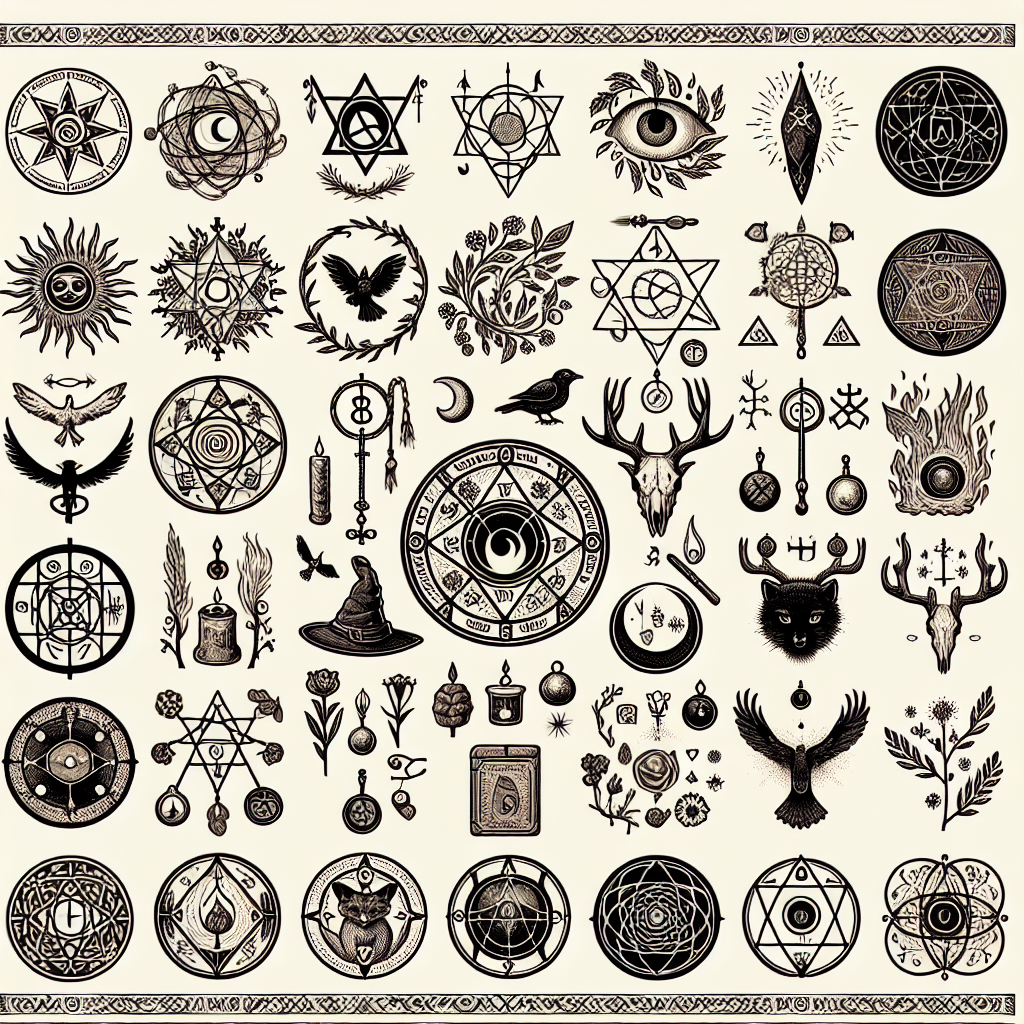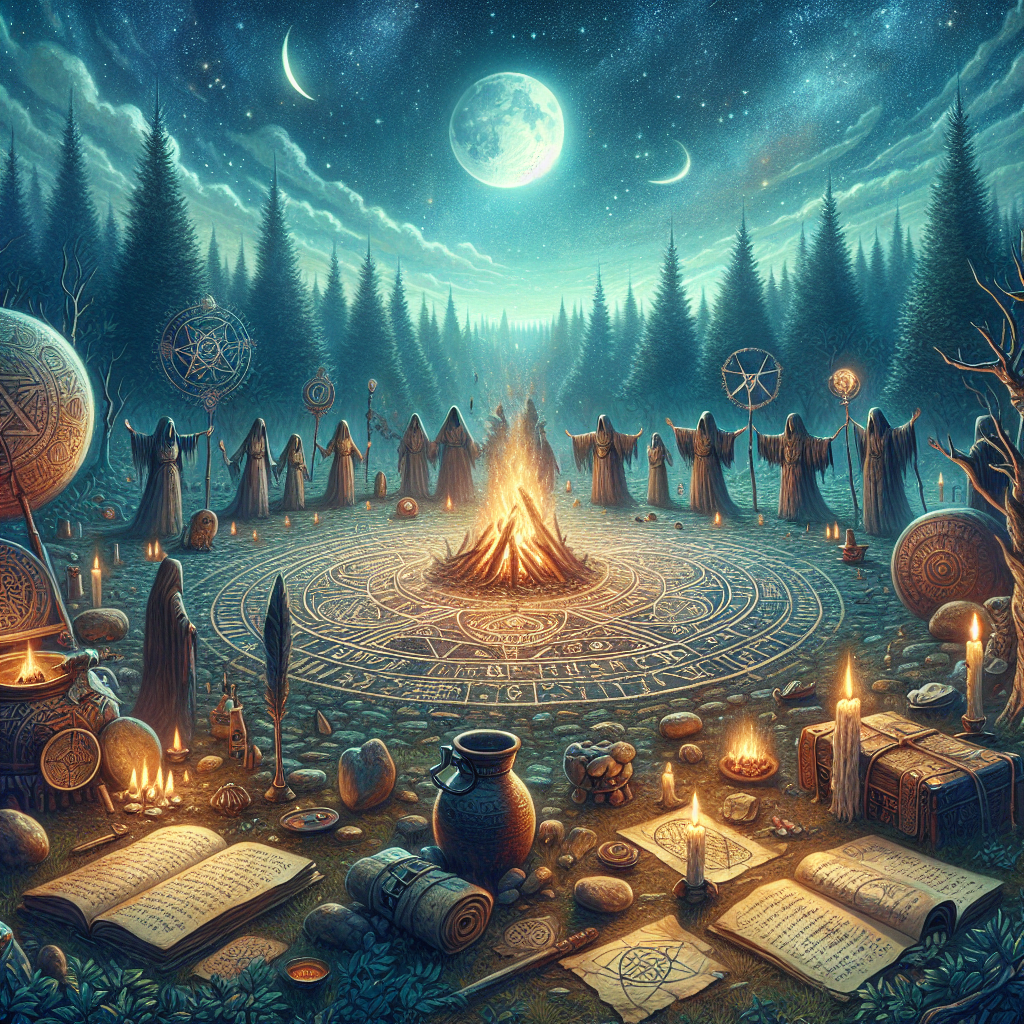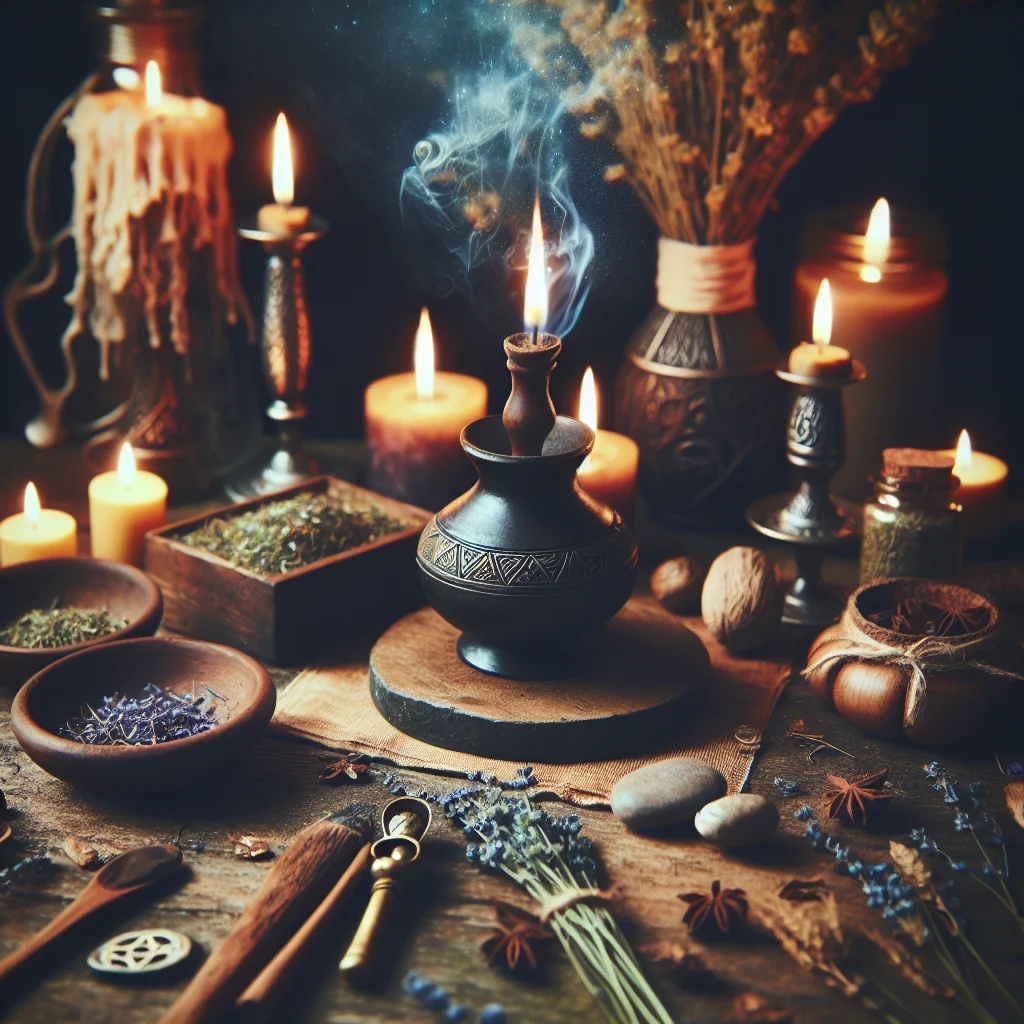As an Amazon Associate I earn from qualifying purchases.

Introduction to Pagan Magic
Pagan magic, also known as witchcraft or witchery, is a diverse and rich aspect of paganism that encompasses various traditions and practices revolving around the harnessing of natural energies. With its roots tracing back to ancient civilizations, pagan magic still holds significant appeal and relevance in modern spiritual practices, addressing the growing desire for personalization in religious and spiritual life. In recent years, a study showed that the number of people identifying as pagan or practicing witchcraft has dramatically increased, evidence of the growing interest and reconnection with these ancient practices.
Ceremonial Magic
Ceremonial magic focuses heavily on rituals and the invocation of supernatural forces through structured and elaborate ceremonies. This type of magic often requires precise preparation and the use of specific ceremonial tools.
Herbal Magic
This form of magic emphasizes the medicinal and magical properties of herbs. Practitioners use plants and natural ingredients to create potions, amulets, and charms for healing and protection.
Crystal Magic
Crystal magic involves the use of gemstones and crystals for their believed vibrational energies. These stones are used for healing, protection, and to amplify energy within rituals.
Candle Magic
Candle magic is one of the simplest forms of magic, relying on the color and intention behind the burning of candles. Each color symbolizes different energies and purposes.
Divination
Divination encompasses a wide range of practices used to gain insight into the past, present, or future. Methods include tarot reading, astrology, and scrying.
Faery Magic
Faery magic is rooted in the belief in and communication with faery beings. This type of magic often involves offerings and rituals to invoke the assistance of faeries.
Green Magic
Green magic focuses on the power of nature and ecological balance. Practitioners work closely with the energies of plants, animals, and the Earth.
Hedge Witchery
Hedge witchery blends shamanic practices and modern witchcraft. Hedge witches are known for their abilities to travel spiritually between worlds and communicate with spirits.
Kitchen Witchery
Kitchen witchery elevates everyday food preparation into a spiritual practice. Ingredients are selected not only for nourishment but also for their magical properties.
Lunar Magic
Lunar magic leverages the phases of the moon to enhance spells and rituals. Each phase offers different energies and opportunities.
Necromancy
Necromancy is the practice of communicating with the deceased to gain insight or harness their power. This type of magic is often seen as dark or taboo.
Protective Magic
Protective magic aims to guard practitioners from physical, emotional, and spiritual harm. Techniques include the creation of protective symbols and wards.
Sea Magic
Sea magic utilizes the energies of the ocean and its inhabitants. Practitioners may use shells, saltwater, and driftwood in their rituals.
Sex Magic
Sex magic involves the use of sexual energy and acts as a powerful means of focusing intent and manifesting desires. This practice is both intimate and spiritual.
Solar Magic
Solar magic harnesses the power of the sun, focusing on themes of light, growth, and energy. This type of magic frequently involves sun symbolism and rituals conducted in sunlight.
Weather Magic
Weather magic seeks to influence or predict the weather, using rituals and spells to summon rain, ward off storms, or invoke fair weather.
Elemental Magic
Elemental magic calls upon the four classical elements—earth, air, fire, and water—to accomplish magical work. Each element corresponds to different purposes and levels of energy.
Diving into the world of Pagan magic and spiritual practices offers an enriching tapestry of ancient wisdom and mystical traditions. Below are 17 types of Pagan magic you should explore, each with its own unique characteristics and historical significance.
**1. Wiccan Magic**
Wiccan magic is one of the most well-known paths within Paganism. It focuses on harnessing natural energies through rituals and spells. Wiccans celebrate the cycles of the moon and sun, and their practices often involve invoking deities, particularly the God and Goddess.
**2. Druidic Magic**
Rooted in ancient Celtic traditions, Druidic magic emphasizes harmony with nature. Druids often use omens and divination tools such as ogham sticks. They are also known for their elaborate rituals in sacred groves and stone circles, focusing on the veneration of nature spirits.
**3. Norse Magic (Seiðr and Galdr)**
Norse magic is split into Seiðr, which often involves trance and prophecy, and Galdr, a form of magic based on incantations. These practices are drawn from ancient Norse mythology and focus on runes and the power of the spoken word.
**4. Hermeticism**
Hermeticism blends mystical and philosophical elements from ancient Egypt and Greece. It emphasizes personal enlightenment and spiritual transformation and includes practices such as alchemy, astrology, and theurgy.
**5. Hoodoo**
Hoodoo, also known as rootwork, is a form of magic that emerged in African American communities. It blends African spiritual practices with Native American, European, and Christian elements. Rootworkers use herbs, roots, and personal items to cast spells and perform rituals.
**6. Voodoo (Voudon)**
Voodoo's roots lie in West African religious practices, and it is especially prominent in Haiti. It involves engaging the loa (spirits) through rituals, dances, and music. Voodoo practices can range from healing and protection to justice and vengeance.
**7. Shamanism**
Shamanism is a practice found in many indigenous cultures worldwide. Shamans act as intermediaries between the physical and spiritual worlds. They use drumming, songs, and natural elements to journey into other realms and communicate with spirits.
**8. Chaos Magic**
Chaos magic is a contemporary path that emphasizes personal experience and adaptability. Practitioners believe in the fluidity of reality and often use sigils, altered states of consciousness, and eclectic rituals based on personal belief systems.
**9. Egyptian Magic**
Egyptian magic originates from the religion and mythology of ancient Egypt. Practitioners utilize hieroglyphs, amulets, and sacred texts. This form of magic is deeply entrenched in the worship of deities like Isis and Osiris and involves complex ceremonies.
**10. Greco-Roman Magic**
Incorporating aspects from both Greek and Roman traditions, this type of magic often involves the invocation of gods, goddesses, and daemons. Practices include the use of spells inscribed on lead tablets (defixiones), the creation of magical figurines, and ritual sacrifices.
**11. Fairy (Fae) Magic**
Fairy magic focuses on working with the spiritual beings known as the Fae. Practitioners often set up altars and offer gifts to attract and honor these elusive entities. Fairy magic blends elements of nature worship and folk customs.
**12. Sumerian/Babylonian Magic**
Ancient Sumerian and Babylonian magic practices involve the recitation of sacred texts and the creation of protective amulets. These rituals often focus on invoking deities like Ishtar and Enki for various needs, from fertility to protection.
**13. Eastern Pagan Magic**
Including a broad spectrum of traditions from Hinduism, Taoism, and Shinto, Eastern Pagan magic practices involve rituals, meditation, and the veneration of spirits and deities. Methods such as yoga, tantra, and feng shui are integral to these practices.
**14. Native American Magic**
Native American magic varies widely among different tribes but generally incorporates visions, dreamwork, and the four elements. Practices include the use of sacred herbs, totems, and ceremonial dances to honor the Great Spirit and other natural deities.
**15. Kabbalistic Magic**
Rooted in Jewish mysticism, Kabbalistic magic involves the study of sacred texts like the Zohar. Practitioners use complex glyphs, numerology, and meditation to attain spiritual enlightenment and magical power.
**16. Sumerian Magic**
Grounded in the traditions of one of the world's oldest civilizations, Sumerian magic involves the worship of gods like Anu and Ea. Rituals often include complex incantations, offerings, and the crafting of symbolic artifacts.
**17. African Traditional Religion (ATR) Magic**
This broad category includes various tribal magic practices across Africa. Common elements are ancestor worship, divination, and ritual dance. Practitioners seek guidance and intervention from ancestral spirits and indigenous deities.
According to recent studies, an estimated 1.5 million people in the United States identify as Pagan or practice some form of Paganism, reflecting a growing interest in these diverse spiritual and magical paths.
Candle Magic
Candle magic is one of the most accessible forms of pagan practices. I remember my first experience vividly: it was during a quiet evening when I lit a blue candle for tranquility. As the flame flickered, I felt an overwhelming sense of calmness washing over me, solidifying my belief in the subtle power of focused intention. Each time I lit a candle thereafter, it became a ritualistic act of grounding and centering, helping me navigate life's complexities.
I eventually expanded my candle magic repertoire, working with other colors and their respective energies. Red candles became my go-to for passion and motivation, while green candles were reserved for abundance and health. I learned that by carving symbols or even writing down my wishes on the candle, I could tailor my rituals to my specific needs. Each ritual felt like a personal ceremony, bridging the gap between the spiritual and the mundane.
The most transformative experience was using candle magic to manifest a new job. I prepared a yellow candle for success and wrote my aspirations on it. Over the next few nights, I meditated on the flame, visualizing myself thriving in a new role. Within a month, I received a job offer that aligned perfectly with my intentions. This deepened my trust in the practice, making candle magic a cornerstone of my spiritual toolkit.
Crystal Magic
Crystals have long captivated me with their intricate beauty and enigmatic energy. My first venture into crystal magic began with a simple quartz crystal. I carried it with me everywhere, and soon noticed subtle shifts in my energy levels and mental clarity. The crystal felt like a miniature reservoir of power, effortlessly amplifying my intentions and providing a steady source of comfort.
As I grew more attuned to various crystals, I began incorporating them into different aspects of my life. Amethyst became a mainstay for stress relief and emotional balance, while citrine was my go-to for boosting creativity and overcoming mental blocks. I developed the habit of meditating with my crystals, aligning their energies with my own through focused breathing and visualization techniques.
One of the most profound moments in my crystal magic journey involved using rose quartz for emotional healing. During a particularly challenging period, I meditated with a rose quartz crystal every day. Holding the crystal against my heart, I envisioned its gentle energy soothing my emotional wounds. Over time, I noticed a significant improvement in my emotional resilience, further validating the transformative potential of crystal magic.
Herbal Magic
Herbal magic opened up a new world of sensory experiences and practical applications for me. My journey began with simple herbs like lavender and chamomile for relaxation and sleep. I remember my first herbal sachet: a small cloth bag filled with dried herbs that I placed under my pillow. The soothing scent and the intention infused into the sachet led to some of the most restful sleep I had ever experienced.
Cooking with intention became another avenue for exploring herbal magic. By incorporating herbs like rosemary for protection and basil for prosperity into my meals, I created not just food but also a tangible form of magic. Each bite became a ritual, transforming everyday meals into spiritual nourishment.
One particularly impactful experience was using herbal teas for healing. When I was grappling with a persistent cold, I created a blend of echinacea, ginger, and honey. As I sipped the warm tea, I focused on the healing properties of each herb. The ritual became a meditative act, and I felt a marked improvement in my symptoms over the following days. Herbal magic thus became an integral part of my wellness routine, blending the practical with the mystical.
Divination Magic
Divination has always fascinated me, offering a glimpse into the unknown and a deeper understanding of the present. My first foray into divination was with a tarot deck I received as a gift. The moment I spread out the cards for my first reading, I felt a powerful connection to the symbols and archetypes depicted. It was as though the cards were speaking directly to my subconscious, revealing insights I had been unaware of.
As I became more proficient with the tarot, I explored other forms of divination such as runes and pendulums. Each method brought its own unique flavor and depth to my practice. I particularly enjoyed using the pendulum for yes-or-no questions, finding its simple movements surprisingly intuitive and accurate. The runes, on the other hand, offered more nuanced guidance, often requiring deep contemplation to interpret fully.
One of the most memorable divination sessions involved a dream interpretation method I stumbled upon. I kept a dream journal and applied various symbolic interpretations to my dreams. Over time, patterns emerged, offering profound insights into my subconscious mind. This holistic approach to divination not only provided answers but also deepened my self-awareness and spiritual growth.
u003cH2u003eWhat is Pagan magic?u003c/H2u003e
u003cpu003ePagan magic refers to a variety of spiritual practices and rituals rooted in ancient pagan traditions. It often involves the use of natural elements, deities, and specific rituals to bring about desired outcomes or spiritual awareness.u003c/pu003e
u003cH2u003eIs Paganism a religion?u003c/H2u003e
u003cpu003eYes, Paganism is considered a religion for many practitioners. It encompasses a wide range of beliefs and practices, often centered around nature worship, polytheism, and ancient traditions.u003c/pu003e
u003cH2u003eAre there different types of Pagan magic?u003c/H2u003e
u003cpu003eYes, there are multiple types of Pagan magic, including but not limited to Wicca, Druidry, Shamanism, Heathenry, and Hellenism. Each type has its own unique beliefs, deities, and magical practices.u003c/pu003e
u003cH2u003eWhat are some common tools used in Pagan magic?u003c/H2u003e
u003cpu003eCommon tools in Pagan magic include the athame (a ritual knife), wands, chalices, pentacles, crystals, herbs, and candles. These tools often symbolize different elements and aid in focusing energy during rituals.u003c/pu003e
u003cH2u003eIs Pagan magic associated with witchcraft?u003c/H2u003e
u003cpu003eWhile not all Pagan magic is witchcraft, many forms of Paganism do incorporate elements of witchcraft. Wicca, for instance, is a modern Pagan witchcraft tradition.u003c/pu003e
u003cH2u003eCan anyone practice Pagan magic?u003c/H2u003e
u003cpu003eYes, anyone with a genuine interest can practice Pagan magic. However, it's important to study and understand the cultural and spiritual significance behind the practices to ensure respectful and effective use.u003c/pu003e
u003cH2u003eAre ancient spells still relevant today?u003c/H2u003e
u003cpu003eMany practitioners believe that ancient spells are still relevant and effective. These spells often carry historical, cultural, and spiritual significance that can enhance their power and meaning.u003c/pu003e
u003cH2u003eHow can I learn more about different types of Pagan magic?u003c/H2u003e
u003cpu003eYou can learn more by reading books, attending workshops or festivals, joining online forums or local groups, and studying with experienced practitioners. Engaging with the community can provide valuable insights and practical knowledge.u003c/pu003e
u003cH2u003eIs Pagan magic safe to practice?u003c/H2u003e
u003cpu003eWhen practiced with respect, knowledge, and caution, Pagan magic can be safe. It's important to understand the potential consequences of any ritual or spell and to ensure that your intentions are ethical.u003c/pu003e
u003cH2u003eCan I combine different types of Pagan magic?u003c/H2u003e
u003cpu003eMany practitioners do combine different types of Pagan magic to create a personalized spiritual practice. However, it's important to approach this with respect for the traditions involved and a clear understanding of how they interrelate.u003c/pu003e

## Conclusion
The exploration of 17 types of Pagan magic reveals a diverse tapestry of spiritual practices that cater to various magical paths and religious beliefs. Each type offers unique methods for connecting with the divine, harnessing natural energies, and fostering personal growth. From Druidry’s deep reverence for nature and ancestors to the structured rituals of Ceremonial Magic, these practices spotlight the rich traditions and ancient wisdom that have persisted through centuries. Folk magic, with its practical and accessible charms, illuminates the everyday magic woven into the fabric of daily life, while shamanism’s focus on healing and spiritual journeys highlights the transformative power of entering alternate realms. Each path, whether it involves ancient spells, elemental magic, or deity worship, underscores the significance of intentionality and the symbiotic relationship between practitioner and practice.
Understanding these 17 types of Pagan magic not only broadens one's spiritual horizons but also deepens appreciation for the myriad ways people have sought to commune with the unseen and shape their destinies. Whether through the intricate symbology in Alchemy or the intuitive practices of Hedge Witchcraft, these magical traditions emphasize a harmonious existence, respect for ancient knowledge, and the nurturing of spiritual growth. They encourage practitioners to explore various techniques and integrate practices that resonate most deeply with their personal spiritual journey. In embracing this diversity, one finds that Pagan magic is not just about ritual and spells but cultivating a profound connection to the universe and oneself.
Amazon and the Amazon logo are trademarks of Amazon.com, Inc, or its affiliates.


